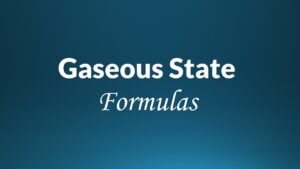Table of Contents
Introduction
Physical chemistry is incomplete without the gaseous state. In terms of physical chemistry, this gaseous state gives insight into the specifications of gases and the equations associated with them. This gaseous state of IIT JEE notes provides a student with a better understanding of the key components that must be studied in order to pass the tests.
Formulas for the Gaseous State
Mass (m):
The number of moles is used to determine the mass of the gas.
n = w/M
Where n is the number of moles.
w = grams of gas mass
M = the gas’s subatomic mass.
Volume (V):
Gases eat up all of the space available to them. As a result, the gas volume is equivalent to the volume of the compartment in which the gas is contained.
Volume is usually expressed in litres (L), centimetres (cm³), and decimeters (dm³).
1m³ = 1000 liter = 10³ dm³ = (10)6 cm³.
Temperature (T):
Temperature is a physical parameter that describes how cold or hot something is. Kelvin is the SI unit of temperature. Temperature is measured in degrees Celsius (°C) and degrees Fahrenheit (°F). Water freezes at 0°C and boils at 100°C on the Celsius scale, whereas it freezes at 273 K and bubbles at 373 K on the Kelvin scale.
K = °C + 273.5
F = (9/5) °C + 32
Boyle’s Law
Robert Boyle was an English chemist and physicist who wrote extensively on the properties of gases. Boyle’s law states that the pressure of a gas is inversely proportional to its volume. In other words, when the volume of a gas is decreased, the pressure of the gas increases. Boyle’s law is a fundamental law of physics and is used to calculate the changes in pressure and volume of gases.
Vα1/P
Vα1P
P1V1 = P2V2
The Law of Charles
Charles’ law is a scientific law that states that the volume of a gas is inversely proportional to the pressure it is exposed to. In other words, when the pressure on a gas is increased, its volume decreases, and vice versa. This law is named after French physicist Jacques Charles, who formulated it in 1787.
Charles’ law is significant because it helps to explain the behavior of gases. It is used, for example, in the manufacture of aerosol cans, where the gas is compressed to decrease its volume.
V∝T
OR
V1/T1 = V2/T2 = constant.
The Law of Combined Gases
This Law states that the pressure of a given mass of a gas legally corresponds to its maximum temperature at a constant volume. Boyle’s Law and Charles’ Law are combined in this law.
(P1V1)/T1 = (P2V2)/T2
Gay Lussac’s Law
When there is no change in volume,
PαT
P1T1 = P2T2 = constant
FAQs
Describe the Gas Kinetic Molecular Theory.
Gases are made up of a huge number of indistinguishable particles (iotas or atoms), which are small, totally rigid circles. Because the true volume of the particles is insignificant in comparison to the space between them, they are referred to as point masses. The particles' association is unimportant. A gas's particles travel in a regular and irregular pattern, and the impact between them is varied. The usual motor liveliness of a gas's particles is directly proportional to its maximum temperature. A gas's pressure is caused by collisions between gas particles and compartment barriers.
Is the gaseous state simple in JEE?
The classic gas equation (PV = nRT) and its variants are the focus of this chapter. As a result, the problems in this chapter are quite simple to solve. All that is needed is the capacity to understand an issue quickly and picture a situation.










